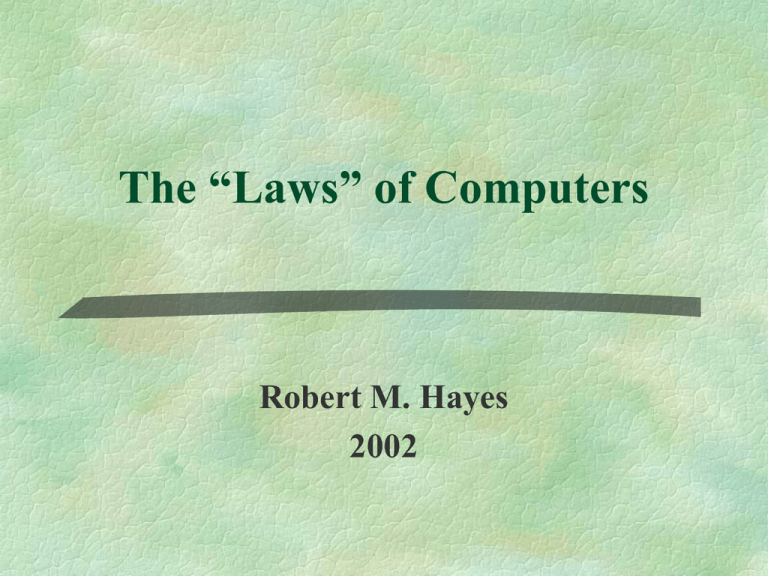The “Laws” of Computers - UCLA Department of Information Studies
advertisement

The “Laws” of Computers Robert M. Hayes 2002 Overview Grosch’s Law General Nature The Rationale The Impact Today Moore's Law General Nature The Origins of Solid-State Electronics The Integrated Circuit The Commentary by Moore in 1965 The Reprise in 1975 The Reprise in 1995 The Implications of Moore's Law As a Basis for Growth of Information Technology As a Guide to Industry As a Context for Software Grosch's Law General Nature The Rationale The Impact Today General Nature - 1 For many years, a reigning theory about the economics of computers was Grosch's Law. It asserted that there were huge economies of scale available because of the rapid increase of capabilities with increasing costs of computers. Accordingly, the profitability of computerization would show up when firms bought large-scale equipment and centralized the workload in data centers for more efficient processing. Herbert R. J. Grosch, an IBM employee at the time he made that assertion and subsequently the head of the U.S. Department of Commerce's National Bureau of Standards, said that "a computer's power increases with the square of its costs". General Nature - 2 Though Grosch never published his work, his theory became the accepted truth for computer capacity planning for more than 20 years. It was never clear whether Grosch's Law was a reflection of how IBM priced its computers or whether it related to actual costs, but it provided the rationale for the view that, for computers, "bigger is better". IBM used Grosch's Law to persuade organizations to acquire more computing capacity, and it became the justification for offering time-sharing services from big data centers to replace distributed computing. The Rationale - 1 There is in fact an underlying rationale for Grosch's law. At the time he formulated it, the internal memory and its associated circuitry was the major component of the variable cost of a computer. All other internal elements, such as the central processing unit and means for dealing with input and output were essentially fixed costs. Peripheral units, such as magnetic tapes as storage devices and printers as means for output were linear costs, but relatively small. At that time, the means for internal storage were magnetic cores, arranged in three-dimensional arrays. The fixed size of a "word" as a unit of memory represented one dimension of the array, and the other two dimensions represented the number of words in the memory. The Rationale – 2 Given that the number of words was a rectangular array, the cost of the circuitry for the memory was the sum of the two rectangular dimensions. Thus, if the size of the memory was N*N words, the cost of the circuitry was 2*C*N. So, the total cost was 2*C*N plus the essentially fixed costs for other internal elements and the linear costs for peripherals. The crucial point is that the power of a computer is primarily dependent upon the size of the internal memory. That determines the size of the program and the amount of data that can be processed internally. Hence, by doubling the cost, from 2*C*N to 2*C*(2*N) one could increase the memory to (2*N)*(2*N) and thus quadruple its size and the power of the computer. The Impact Today Today the situation is totally different as we will see in a moment when we consider Moore's Law. The size of the internal memory has become almost insignificant as part of the cost of the computer, and internal memories of hundreds of megabytes are common, even in personal computers. As yet, there is no evidence that computer investments are exhibiting economies of scale. The now virtually irrelevant Grosch's Law should serve as a reminder that the history of the economics of computing has had an abundance of unsupported misperceptions or at most temporarily realistic perceptions. Ideas of how to invest in new equipment acquire temporary popularity until they are conveniently abandoned for yet another rationalization of how to spend money. Moore's Law General Nature The Origins of Solid-State Electronics The Integrated Circuit The Commentary by Gordon E. Moore in 1965 The Reprise in 1975 The Reprise in 1995 General Nature "Moore's Law" is the observation, made in 1965 by Gordon E. Moore, that semiconductor circuit densities had doubled on a regular basis for the prior several years. He projected that they would continue to do so for the foreseeable future. That prediction has been validated and now carries with it enormous influence. The manufacturers regard Moore's Law as a challenge, which they have continued to meet. As a result, it has led users to expect a continuous stream of faster, better, and cheaper information technology products. The most recent behavior is shown in the following chart: The Origins of Solid-State Electronics It is worth briefly reviewing the context for Moore's law in the invention of the "transistor" in 1947 by Bell Laboratory researchers. It created a new era of solidstate electronics, and the 1950s saw significant progress in the creation of an entire new industry that would design and manufacture semiconductor devices. The Integrated Circuit - 1 The development of the integrated circuit in 1958 represents a major product milestone, made possible by overcoming technological barriers. One innovation was the introduction of a masking process which allowed the laying of intricate patterns on the semiconductor. A second innovation was to flatten the structure into a plane enabled electrical connections to be made, not laboriously by hand, but by depositing an evaporated metal film on appropriate portions of the semiconductor wafer. The "microchip" was born out of the planar transistor. Most significantly, the planar process enabled the integration of circuits on a single substrate since electrical connections between circuits could be accomplished internal to the chip. The Integrated Circuit – 2 Fairchild introduced the first planar transistor in 1959 and the first planar integrated circuit in 1961. Moore views the 1959 innovation of the planar transistor as the origin of "Moore's Law." Perhaps more than any other single process innovation, planarization set the industry on its historical exponential pace of progress. Amazingly, the industry has not veered from this course since then. With time, chip manufacturers improved the masking process with more precise photographic methods, and "photolithography" thus became the standardized production method for the industry. More pertinent to "Moore's Law," photolithography enabled manufacturers to continue to reduce feature sizes of devices. The Commentary by Moore in 1965 In the April 19, 1965 issue of Electronics there was an article entitled, "Cramming more components onto integrated circuits," by Gordon E. Moore, then Director, Research and Development Laboratories, Fairchild Semiconductor. Moore had been asked by Electronics to predict what would happen in the semiconductor components industry over the next 10 years—to 1975. He speculated that by 1975 it would be possible to squeeze as many as 65,000 components on a single silicon chip occupying an area of only about onefourth a square inch. The Commentary by Moore in 1965 His reasoning was, "The complexity for minimum component costs has increased at a rate of roughly a factor of two per year. Certainly over the short term this rate can be expected to continue, if not to increase. Over the longer term, the rate of increase is a bit more uncertain, although there is no reason to believe it will not remain nearly constant for at least 10 years." The Reprise in 1975 - 1 Ten years later, Moore delivered a paper at the 1975 IEEE International Electron Devices Meeting in which he reexamined the annual rate of density-doubling. Amazingly the plot had held through a scatter of different complex types of devices introduced over the ten-year period. And a new device to be introduced in 1975 indeed contained almost 65,000 components. In this paper, Moore also offered his analysis of the major contributors to or causes of the exponential behavior. He cited three reasons. First, micro-chip sizes were getting bigger and manufacturers could work with larger areas without sacrificing quality. Second, there was a simultaneous evolution to finer feature sizes or line widths. Third was what Moore called "circuit and device cleverness." The Reprise in 1975 - 2 But Moore concluded, "There is no room left to squeeze anything out by being clever. Going forward from here we have to depend on the two size factors—bigger (chips) and finer dimensions." So Moore revised his annual rate of circuit density-doubling, concluding that every eighteen months was a reasonable rate. He redrew the plot from 1975 forward with a less steep slope reflecting a slowdown in the rate, but still behaving in a log-linear fashion. So, Moore's Law now states that circuit density or capacity of semiconductors doubles every eighteen months. The Reprise in 1995 In 1995 Moore compared the actual performance against his revised projection of 1975. Amazingly, it tracked the slope of the exponential curve fairly closely. Chip sizes had continued to increase while line widths had continued to decrease at exponential rates consistent with his 1975 analysis. In early-1996 IBM claimed that a gigabit (billion bits) memory chip was actively under development and would be commercially available within a few years. And papers presented at a 1995 IEEE International Solid-State Circuits Conference contend that terachips (capable of handling a trillion bits or instructions) will arrive by the end of the next decade. The Implications of Moore's Law As a Basis for Growth of Information Technology As a Guide to Industry As a Context for Software Growth of Information Technology The implications of Moore's Law are quite obvious and profound. As more computing power can be placed on a single micro-chip, greater power can be obtained at virtually the same cost. As long as Moore's law continues to apply, therefore, the capabilities of information technology will also grow exponentially. As Moore says, "By making things smaller, everything gets better simultaneously. There is little need for tradeoffs. The speed of our products goes up, the power consumption goes down, system reliability, as we put more of the system on a chip, improves by leaps and bounds, but especially the cost of doing things electronically drops as a result of the technology." As a Guide to Industry Perhaps the broadest implication of Moore's Law is that it has become an almost universal guide for the entire industry. In a sense, Moore's Law represents not the physics and chemistry of semiconductors but the effect of organizational efforts. In that respect, Moore's Law has become almost a self-fulfilling prophecy, since it has guided industrial developments. As a Context for Software - 1 There is another side to this picture, though. While the theoretical capabilities have grown exponentially, that by no means guarantees that those capabilities will be effectively used. Recall that the underlying rationale for Grosch's Law was that the size of memory determined the power of the computer because of the size of program and amount of data that could be stored internally. As a Context for Software - 2 In the early days of computing, internal memory was costly and scarce. As a result, software had to fit into limited memory. That meant efficient use of memory or what was called "tight" code. But now the situation is dramatically different. Under Moore's Law average PC memory sizes have grown at an exponential rate. Thus, software has no longer been constrained to "tight spaces". The result has been the proliferation of thousands, then many thousands, and now millions of "lines of code" as the norm for complex system software. As a Context for Software - 3 In 1975, the programming language Basic had 4,000 lines of code. In 1995, it had roughly half a million. In 1982, the first version of Microsoft Word consisted of 27,000 lines of code. In 2002 it has grown to about 2 million. So the size and complexity of software has increased even faster than Moore's Law. As a result, software has become a much larger part of the cost of a computer system. More complex software requires more memory and more processing capacity, and software designers have come to expect that they will be available. Indeed, "software expands to fill the available memory". THE END






